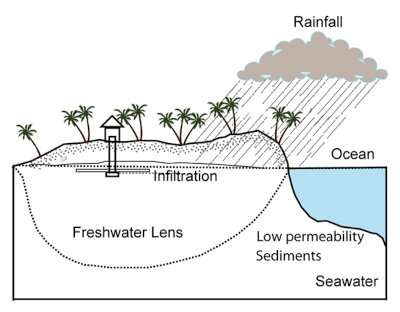Lake formation and expansion due to sea-level rise causes freshwater resource depletion on small islands

Portland, Ore., USA: Coastal regions and small ocean islands face significant risks from rising sea levels due to climate change, because waters can flood and inundate low-lying land surfaces. “Climate change has become a more critical issue recently, especially for island countries and island provinces like the Bahamas. They are not only facing a water shortage problem because of the limitations of the islands, but also they are facing a coastal inundation problem due to sea level rise caused by climate change,” said Yipeng Zhang, a postdoctoral associate at the University of Texas at El Paso.
Zhang will present research on Wednesday at the Geological Society of America’s Connects 2021 annual meeting in Portland, Oregon, that evaluates the impact on freshwater resources on small tropical islands due to sea level rise.
“What makes the news quite a bit, rightfully so, when we think about sea-level rise and islands is inundation and loss of land, especially for low-lying islands, but our focus is water resources,” said Alex Mayer, a professor of civil engineering at the University of Texas at El Paso and principal investigator of this freshwater resource project. “In island aquifers, freshwater is usually found on a lens sitting on top of seawater, due to density differences. That [freshwater] lens can be a very precious and valuable resource especially because many of these islands don’t have access to sufficient surface water resources, so they’re maybe completely dependent on the groundwater.”
While it has been well known that freshwater lenses shorten as sea level rises and the coastline becomes inundated, thus putting freshwater resources at risk, Zhang and Mayer’s research group focuses on the effects of lakes forming and expanding on small islands. As sea level rises, there will be more flooding or inundation in the center interior of islands, so lakes or wetlands will expand laterally, and lakes may even form where there were none previously.
“The lakes are in hydrologic connection to the groundwater. Evaporation rates from the lake are much greater than the evaporation rates from the land surface, and so the lakes can act as a pump, essentially, in drawing water from below. And that can result in saltwater coming up all the way to the surface,” said Mayer.
This “pumping” effect that brings saltwater to the surface can divide and compromise the lens of freshwater, thereby reducing the volume of available freshwater to use for drinking and other needs. To investigate the impact of expanding lakes on freshwater resources, Zhang and Mayer modeled different scenarios using a 30-year climate record from San Salvador Island in the Bahamas and different rates of sea-level rise with seasonal climate variability.
Zhang’s work in particular focuses on the effect of mixing at the interface of the freshwater lens and saltwater below, because mixing between these layers can contaminate the freshwater. As sea level rises and lakes form and expand, the mixing zone increases, consequently reducing the available freshwater. Seasonal climate variations between wet and dry phases also cause enhanced mixing, since the lens will grow in the wet season and retract in the dry season, thus moving back and forth in a cyclical motion.
Understanding the impact of sea-level rise and lake formation on freshwater lens resources is critical in developing sustainable groundwater management strategies for ocean islands. For islands that rely on this groundwater as their main source of potable water, desalination may become an inevitable part of their future.
“I would hope there’s some kind of climate justice involved, too, to help island nations overcome the problems of sea-level rise,” said Mayer. “In my mind, the island nations did not cause the problem, it’s the responsibility of the industrialized nations.”
Many low-lying atoll islands could be uninhabitable by mid-21st century
Yipeng Zhang et al, Freshwater resource depletion on ocean islands as lakes form and expand with sea level rise, Geological Society of America Abstracts with Programs (2021). DOI: 10.1130/abs/2021AM-370157
Citation:
Lake formation and expansion due to sea-level rise causes freshwater resource depletion on small islands (2021, October 12)
retrieved 12 October 2021
from https://phys.org/news/2021-10-lake-formation-expansion-due-sea-level.html
This document is subject to copyright. Apart from any fair dealing for the purpose of private study or research, no
part may be reproduced without the written permission. The content is provided for information purposes only.
For all the latest Science News Click Here
For the latest news and updates, follow us on Google News.

